仁爱版九年级上册教案
- 格式:docx
- 大小:13.37 KB
- 文档页数:10
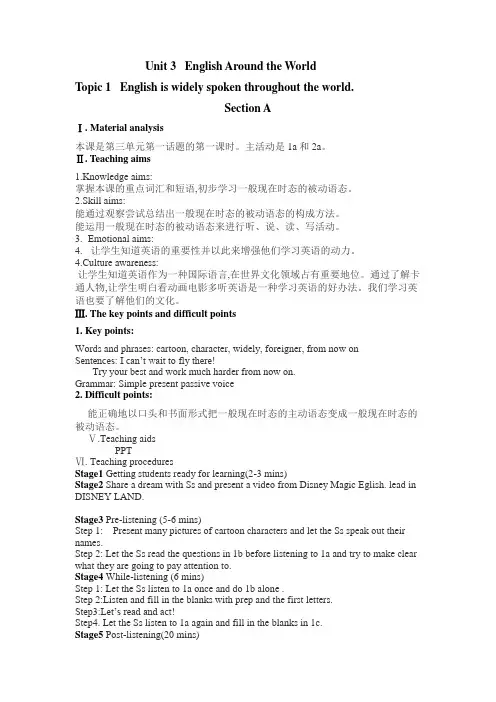
Unit 3 English Around the WorldTopic 1 English is widely spoken throughout the world.Section AⅠ. Material analysis本课是第三单元第一话题的第一课时。
主活动是1a和2a。
Ⅱ. Teaching aims1.Knowledge aims:掌握本课的重点词汇和短语,初步学习一般现在时态的被动语态。
2.Skill aims:能通过观察尝试总结出一般现在时态的被动语态的构成方法。
能运用一般现在时态的被动语态来进行听、说、读、写活动。
3.Emotional aims:4.让学生知道英语的重要性并以此来增强他们学习英语的动力。
4.Culture awareness:让学生知道英语作为一种国际语言,在世界文化领域占有重要地位。
通过了解卡通人物,让学生明白看动画电影多听英语是一种学习英语的好办法。
我们学习英语也要了解他们的文化。
Ⅲ. The key points and difficult points1. Key points:Words and phrases: cartoon, character, widely, foreigner, from now on Sentences: I can’t wait to fly there!Try your best and work much harder from now on.Grammar: Simple present passive voice2. Difficult points:能正确地以口头和书面形式把一般现在时态的主动语态变成一般现在时态的被动语态。
Ⅴ.Teaching aidsPPTⅥ. Teaching proceduresStage1 Getting students ready for learning(2-3 mins)Stage2 Share a dream with Ss and present a video from Disney Magic Eglish. lead in DISNEY LAND.Stage3 Pre-listening (5-6 mins)Step 1: Present many pictures of cartoon characters and let the Ss speak out their names.Step 2: Let the Ss read the questions in 1b before listening to 1a and try to make clear what they are going to pay attention to.Stage4 While-listening (6 mins)Step 1: Let the Ss listen to 1a once and do 1b alone .Step 2:Listen and fill in the blanks with prep and the first letters.Step3:Let’s read and act!Step4. Let the Ss listen to 1a again and fill in the blanks in 1c.Stage5 Post-listening(20 mins)Step 1: Let the Ss check the answers to 1b and 1c with their partners. Then, check the answers together.Step2: check the answers .Step3: Let the Ss study the example in 2a and try to complete the sentences, and find out how to change the active voice into the passive voice.Step 4: Let the Ss work in groups by following the example . Make sure the Ss understand how to practice and exercise.Step5:Let the Ss read 1a again and underline the passive voice, the new words and the useful phrases and sentences. Encourage the Ss to guess other key points.Stage6 Summarizing and assigning homework (5 mins)Teaching reflecting:。
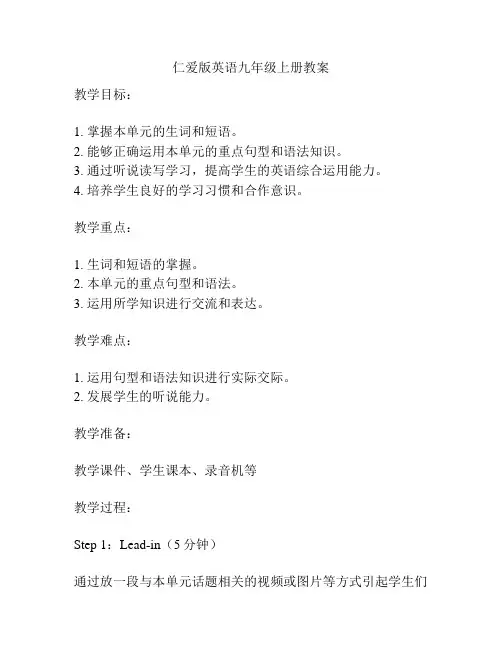
仁爱版英语九年级上册教案教学目标:1. 掌握本单元的生词和短语。
2. 能够正确运用本单元的重点句型和语法知识。
3. 通过听说读写学习,提高学生的英语综合运用能力。
4. 培养学生良好的学习习惯和合作意识。
教学重点:1. 生词和短语的掌握。
2. 本单元的重点句型和语法。
3. 运用所学知识进行交流和表达。
教学难点:1. 运用句型和语法知识进行实际交际。
2. 发展学生的听说能力。
教学准备:教学课件、学生课本、录音机等教学过程:Step 1:Lead-in(5分钟)通过放一段与本单元话题相关的视频或图片等方式引起学生们对本单元话题的兴趣。
Step 2:Presentation(15分钟)通过教师示范和学生跟读的方式让学生们掌握本单元的新词汇和短语。
Step 3:Practice(20分钟)1. 分组讨论与本单元话题有关的问题,并通过听录音或老师的指导引导学生们进行讨论。
2. 运用本单元的重点句型和语法知识进行练习,强化学生的语言表达能力。
3. 小组活动:学生分为小组,每个小组选择一个话题进行讨论和表演,鼓励学生用所学知识进行实际应用。
Step 4:Production(15分钟)组织学生进行口语交流活动,要求学生们能够运用所学知识进行实际交流,鼓励他们提出问题和回答问题。
Step 5:Review and Homework(5分钟)复习本课的重点句型和语法,并布置相关的笔记或练习题作为课后作业。
Step 6:Summarize and Evaluation(5分钟)总结本节课的内容和重点,给予学生一些反馈和评价,鼓励他们继续努力。
教学延伸:1. 可以邀请英语专业的外教来进行口语指导和交流。
2. 可以通过组织学生进行角色扮演等活动来增强学生的语言表达和沟通能力。
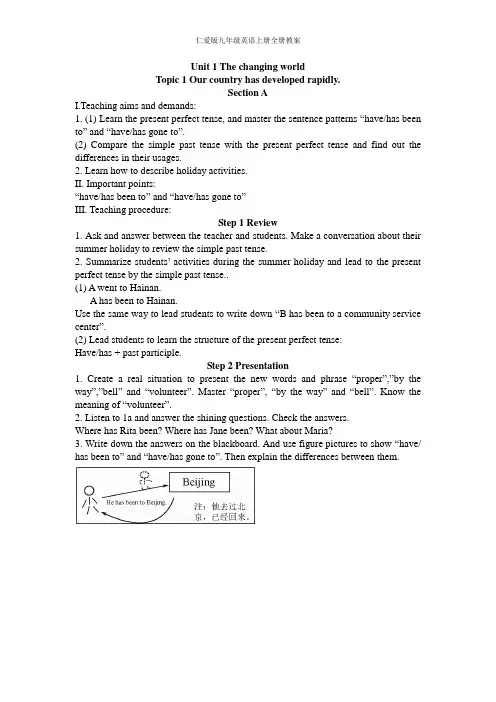
Unit 1 The changing worldTopic 1 Our country has developed rapidly.Section AI.Teaching aims and demands:1. (1) Learn the present perfect tense, and master the sentence patterns “have/has been to” and “have/has gone to”.(2) Compare the simple past tense with the present perfect tense and find out the differences in their usages.2. Learn how to describe holiday activities.II. Important points:“have/has been to” and “have/has gone to”III. Teaching procedure:Step 1 Review1. Ask and answer between the teacher and students. Make a conversation about their summer holiday to review the simple past tense.2. Summarize students’ activities during the summer holiday and lead to the present perfect tense by the simple past tense..(1) A went to Hainan.A has been to Hainan.Use the same way to lead students to write down “B has been to a community service center”.(2) Lead students to learn the structure of the present perfect tense:Have/has + past participle.Step 2 Presentation1. Create a real situation to present the new words and phrase “proper”,”by the way”,”bell”and “volunteer”. Master “proper”, “by the way”and “bell”. Know the meaning of “volunteer”.2. Listen to 1a and answer the shining questions. Check the answers.Where has Rita been? Where has Jane been? What about Maria?3. Write down the answers on the blackboard. And use figure pictures to show “have/ has been to” and “have/has gone to”. Then explain the differences between them.Step 3 Consolidation1. Listen to 1a again and finish 1b. Retell the dialog according to 1a, and talk about the children’s vacation experience with “has been/gone to”.2. Let students find out something important and difficult in 1a. The teacher writes down the sentences on the Bb and explain them.3. Read 1a in groups and choose several groups to act it out. Finish 1a.4. Work in groups. Make up dialogs like 1a according to students’ real situations and act them out I pairs. Finish 1c.Step 4 Practice1. Let students look at the picture in 2 and read the dialogs aloud. Fill I the blanks. Finish2. Let students have a better understanding about the differences between “have/has been to” and “have/has gone to”.2. Learn and master the new words “grandpa”, “chairwoman”and “grandson”by using word formation.3. Let students find different sentence patterns of the perfect tense in this section and practice them.Step 5 Project/work after class1. Free work..2. Do some exercise about “have/has been” and “have/has gone”.Handwriting:Our country has developed rapidly.Section Aby the way —Where have you been, Jane?There goes the bell. —I have been to …proper Maria isn’t at school. Where’s she?chairwoman —She has gone to …Section BI.Teaching aims and demands:1. Go on learning the usage of the present perfect tense.2. Compare the teenagers’life in the past with that nowadays and lead students to cherish the happy life at present.II. Important points:1. Past Participle2. The usage of the present perfect tenseIII. Teaching procedure:Step 1 Review1. Check the work after class.2. Ask and answer between the teacher and students. Review the present perfect tense.Step 2 Presentation1. Show some pictures of disabled children. Make a dialog with students to know whether they have helped disabled children and lead to 1a. Understand the new word “disabed” and master “ever”.2. Listen to 1a and answer the shining questions:(1)Has Maria ever helped disabled children?(2)What did she do to help them?Step 3 Consolidation1. Let students read 1a and find out the important sentences and the sentences with the present perfect tense. The teacher writes them down on the Bb and explain them. Finish 1a.2. Let students observe the past participle of verbs in the five sentences with the present perfect tense on the Bb. Learn the rules of the past participle of verbs. Fill in the blanks in 1b with different forms of the verbs. Master the new words “shut” and “rope”. Know the new word “online”. Check the answers.3. Make a survey about students’summer holidays. Then make up dialog in pairs according to the table in 1b. Encourage students to take part in outdoor activities. Finish 1b.Step 4 Practice1. Show two pctures about the life of teenagers in the past and at present and then make a comparison. Lead to 2a. Learn and master the new words and phrase “describe”, “in detail”, “education”, “develop”and “development”. Understand the words “teenagers”, “childhood”, “support” and “laborer”., Know about the new word “rapidly”.2. Let students listen to 2a and answer the shining question:How did most children spend their childhood in the past?3. Read 2a after the tape. Let students mark the stresses and sense-groups. Then erase the marks. Read 2a aloud in imitation of the tape.4. Read 2a again. Master the new word “granny”and know about the new word “luckily”. Finish 2a. Compare the different lifestyles in the past and at present of Chinese teenagers. Finish 2b.5. Let students listen to 2c and fill in the blanks. Check the answers. Finish 2c.Step 5 Project/work after class1. Free work.2. Do some exersice in TOPENGLISH.Section CI.Teaching aims and demands:1. Go on learning the present perfect tense.2. Compare the past Beijing with the present Beijing and learn about the great changes in China.3. Inspire students to cherish the happy life at present and to cultivate their patriotism. II. Important points:1. some new words and phrases2. (1)My granny has lived in Beijing for more than forty years.(2)Beijing has made rapid progress and it has already succeeded in hosting the 2008 Olympic Games.III. Teaching procedure:Step 1 ReviewReview 2a of Section B. Let two students come to the front to talk about the different lifestyles in the past and nowadays of Chinese teenagers. Lead to the comparison between the old and today in Beijing.Step 2 Presentation1. Let students look at the pictures in 1a. Discuss with students the differences in life between the old days and today, then lead to the passage and let students master the new words and phrases “communication”, “quick”, “keep in touch with”, “far away”, “sort”, “rapid”, “progress”, “make progress”, “already”and “succeed”. Understand the new words “narrow”, “relative”, “telegram”, “reform and opening-up” and “fax”. Know about “leisure” and “mainly”.2. Let students skim 1a and find out the topic sentence of 1a. Check the answer.3. Let students read 1a and answer the shining questions. Check the answers.(1) Who has seen the changes in Beijing?(2) How long has Kangkang’s granny lived in Beijing.(3) How were the living conditions in Beijng in the 1960s?(4) How can Chinese children study at present?(5) What do people use to keep in touch with their friends and relatives nowadays? 4. Let students read 1a by themselves and find out the important and difficult points. The teacher writes them down on the Bb and explains the difficult ones.Step 3 Consolidation1. Let students read 1a again and finish 1b. Then check the answers.2. According to the pictures in 1a and the words below them, let students at least two studets for each picture.Step 4 Practice2. Make up dialogs in pairs shining the example in 1c according to the table and finish 1c.3. Lead students to think about the question “Why has Beijing changed so rapidly?”Lead them to cultivate their patriotism.4. Work in groups. According to the table above, let students retell 1a in groups on the basis of 2, Step 3, using the words and sentences they’ve learnt.Step 5 Project/work after class1. Free work.2. Do some exersice in TOPENGLISH.Section DI.Teaching aims and demands:1. Review and sum up the present perfect tense.2. Learn the basic steps of writing a composition.3. Let students get acquainted with the changes in their hometowns and stimulate their love for their hometowns.II. Important points:1. Some new words and phrases2. The present perfect tenseIII. Teaching procedure:Step 1 Review1. Let students listen to the song Spring Has Arrives! Review the present perfect tense and warm up.2. The teacher tells students that he/she likes enjoying music best in his/her free time and ask about students’ leisure activites. Lead to 2.Step 2 Presentation1. Show the pictures in2. Know about the meaning of each picture.2. Work in groups. Make a survey about students’leisure activities, and then make dialogs according to the example in 2. Finish 2.3. Show a picture of some children who are helping some old people. Lead to 1 by asking and answering between the teacher and students.Step 3 Consolidation1. Listen to 1. Fill in the blanks with the help of the words on the left.2. Listen to 1a again. Check the answers. Finish 1.3. Educate students to respect and care about the old.Step 4 Practice1. Review and sum up the present perfet tense and important sentence patterns together in this topic.2. Listen to 3a and 3b. Then let students compare them with what they have summed up. Finish 3a and 3b.3. Work in pairs. Let students look at the poctures in 4, then discuss the shining question:What changes have taken place in Li Ming’s hometown?Then ask three students to summarize the changes.4. Let students read “Notes” and “Outline” in 4 and learn and master the new words and phrases “composition”, “note”, “consider”, “draw up”, “tool”, and “thanks to”. Learn the basic steps of writing a composition. Finish 4.Step 5 Project/work after classWrite a composition entiled “Changes in LiMing’s Hometown”.Topic 2 China has the largest population.Section AI.Teaching aims and demands:1. Learn the present perfect tense with “just”, “already”, “yet”, “ever” and “never”.2. Talk about population.3. Lead students to care about the population problem and build up right ideas of population.II. Important points:1. yet, probably, call up, European, population, recent, because of, policy, neither2. (1) So do I.(2) Neither do my parents3. the present perfect tense with “just”, “never”, “yet”, “ever” and “already”III. Teaching procedure:Step 1 Review1. Ask two students to come to the front to talk about the changes of their hometowns.2. Show some pictures that can reflect the large population of China. Practice a dialog with students. Lead to Topic 2 China has the largest population.Step 2 Presentation1. Let students listen to 1a and answer the question: “Where has Kangkang been?”Check the answer.2. Let students read 1a by themselves, and finish 1b. Check the answers. Let students guess the meanings of “yet”, “probably” and “call up” from the context. The teacher gives explanation. Then ask them to master them.3. Let students find out the important and difficult points and the sentences with the present perfect tense. Then write them down on the Bb and help students to understand them..Step 3 Consolidation1. Let students read 1a after the tape. Pay attention to the pronunciation and intonation.2. Work in pairs. Let students read 1a, and then act it out. Finish 1a.3. Add another two sentences “Have you ever fed them?” and “Beijing has made rapid progress and it has already succeeded in hosting…”to the sentences in 3, Step 2, written on the Bb. Make students know how to use the five underlined words, then help students to sum up the usages of them.4. Complete the conversation in 2, and check the answers. Teach and let students master “European”. Then act it out in pairs. Finish 2.5. Chain drill. Ask students to make sentences with “just”, “never”, “yet”, “ever”and “already”. Then let them give their sentences one by one in groups.Step 4 Practice1. Let students sing the song If You’re happy. Lead to 3a.2. Listen to 3a and answer the two questions the teacher asked, then check the answers.3. Let students read 3a by themselves and find out the important and difficult points. Then solve them together. Learn and master the new words “recent” and “neither”.4.Let students read 3a again and finish 3b. Then check the answers.5. Work I pairs. First, let students act 3a out. Then let the whole class choose the best pair and give them praise. Finish 3a.Step 5 Project/work after class1. Free work.2. Do some exersice in TOPENGLISH.Section BI.Teaching aims and demands:1. Go on learning the present perfect tense.2. Learn how to express big numbers in English.3. Talk about the population in different countries.II. Important points:1. the numbers with million and billion.2. some useful sentences(1) It says the world has a population of 6.5 billion.(2) It is increasing by 80 million every year.(3) Which country has the largest population?(4) —What’s the population of the U.S.A.?—It’s…(5) So it is.(6) The population problem is more serious in developing countries.III. Teaching procedure:Step 1 Review1. Check the homework.2. Let students report the information about China’s population that they have collected. Lead to 1a. Then the teacher sums up.3. Write down the new words “increase”and “billion”on the Bb. Ask students to master the new word “increase” and understand the new word “billion”.Step 2 Presentation1. Listen to 1a and answer the shining questions:(1) What’s the population of the world.(2) Which country has the second largest country?2. Let students skim 1a, find out the numbers in the dialog and make dialogs in pairs according to the chart and examples in 1b. Finish 1b.3. Let students read 1a and find out the important and difficult points. Write them down on the Bb and encourage students to solve the problems. Give students some proper complements.Step 3 Consolidation1. Let students read 1a again and underline the key words. Let students change the dialog of 1a into a short passage and try to retell it with the help of the key words.2. Work in pairs. Let students read 1a and act it out. Finishi 1a.Step 4 Practice1. First the teacher writes a two-digit number, then adds a new digit to the number each time. Ask students to read the numbers, correct them properly when they make mistakes, and then sum up how to read and write numbers in English. For example: 22,222,2222,…,22222222222. Let students read the numbers in 2a. Ask students to express the numbers skillfully with the words “hundred”, “thousand”, “million”and “billion”. Help them when necessary and then chenk the answers. Finish 2a.3. Let students listen to 2b and dinish it by themselves. Check the answers.4. Play a number game.(optional)Step 5 Project/work after class1. Free work.2. Do some exersice in TOPENGLISH.I.Teaching aims and demands:1. Go on learning the present tense.2. Go on talking about the problem of the increasing population.3. Lead students to have right ideas of population.II. Important points:1. some new words and phrases2. (1) … and about one fifth of the people in the world live in China.(2) … our government has taken many measures to control the population.(3) Thanks to the policy, China is developing quickly and people’s living conditions are improving rapidly.(4)It’s difficult for lots of people to find jobs.(5)…, we are short of energy and water.(6)Most cities are more crowded than before, and the traffic is much heavier.III. Teaching procedure:Step 1 Review1. Show some cards with big numbers, and let one student read the numbers and the others listen to him/her and write them down. Then check the answers.2. Ask some questions to review Section B, talk about the population problem, and then lead to 1a.Step 2 Presentation1. Let students discuss the questions in 1a. Show same pictures of the problem caused by China’s large population, such as difficult job-hunting, less living space, less water, heavy traffic,environment pollution,etc. The teacher sums up the problems and lets students master the new word and phrases “difficulty”, “be short of”and “so far”. Know about “measure” and “take measures to do sth.”2. Listen to 1a and finish 1b, and then check the answers.3. Let students read 1a and find out the key sentences. Lead students to sum up. Then write them down on th Bb and explain.Step 3 Consolidation1. Let students listen to 1a again write the key words. For example: “the world’s population”, “the largest population”, “one fifth”, “many difficulties”, “policy”, “work well”,…2. using these key words, the teacher leads students to review 1a by asking them questions. Use “one fifth” to lead to “20 percent”, and let students learn and master the new word “percent”. Finish 1a.Step 4 Practice1. Listen to 2a and finish it alone, then check the anwsers. Learn and know about “newborn”.2. Read 2a, finish 2b alone and check the answers.Step 5 Project/work after class1. Free work.2. Do some exersice in TOPENGLISH.Handriting:I.Teaching aims and demands:1. Review and consolidate the usage of the present perfect tense.2. Know about the life in cities and the life in the countryside in China and Canada.3. Talk about different types of families and know about the advantages and disadvantages of them.II. Important points:1. unless, couple, a couple of, market, excellent, keep up with, relation, belong to2. the present perfect tenseIII. Teaching procedure:Step 1 Review1. Check the homework.2. Practice betweenthe teacher and students to review Section C.3. Ask students “Do you like living in a place with a large population or a small one?”and lead to 1a.Step 2 Presentation1. Let students talk about their living conditions freely and discuss the teacher’s question. Then introduce a student’s living conditions in a town. And let students learn and master the new words and phrase “couple”, “a couple of”, “market”, “excellent” and “relation”. Know about “transportation”.2. Let students read 1a. Learn and master the new word and phrase “unless”and “keep up with”. Then lead students to find out the useful expressions. The teacher explains these exprssions and asks students to master them.3. Let students listen to 1a, write down the key words and phrases as they are listening, and try to retell 1a according to these key words and phrases.Step 3 Consolidation1. Work in pairs. Read 1a and discuss “What are the differences between Sue’s livingcheck the answers.Step 4 Practice1. Discuss the question “Has Canada developed more quickly than China?”, using the present perfect tense.2. Lead students to sum up the present perfect tense(II). Then let them listen to 2a and read after the tape. Consildte the usage of the present perfect tense. Finish 2a.3. Lead students to sum up the important phrases and sentences in Topic 2. Then let students listen to 2b and read after the tape. Consolidate the usages of these phrasesand sentences. Finish 2b.Step 5 Project/work after class1. Free work.2. Do some exersice in TOPENGLISH.Handwriting:Topic 3 The world has changed for the better.Section AI.Teaching aims and demands:1. Learn the sentences of the present tense with “for” and “since”.2. Learn the word formation of derivatives.3. Learn to care about and describe social development and changes.II. Important points:1. some new words and a phrase2. the present perfect tense with “for” or “since”III. Teaching procedure:Step 1 Review1. Competition.(1) Divide students into several groups. Let students give the participle quickly after the teacher says a verb. Then choose the best group and give praise.(2) Show the shining words with a small Bb. Ask students to add some letters to the words make up new words after the examples. Lead to the formation of derivatives: root+suffix, prefix+root.2. Lead students to sum up the rules that govern the formation of derevatives. With the help of these rules, learn and master the new words “discover”, “direct”, “possible”, “fair”, “invention” and “excite”. Finish3.Step 2 Presentation1. Show some pictures of New York. Then ask and answer between the teacher and students. Learn and master the phrase “as a matter of fact”.2. Listen to 1a, and answer the shining questions:(1) Does Bob like living in New York?(2) Were the streets in New York dirty in the past?(3) Can Bob go to plays, concerts and operas every day in New York?3. Let students read 1a, then find out and master the useful expressions in 1a. The teacher explains them. For example:You’ve been in New York for a long time.Oh, you will get used to it very soon if you come.They used to be, but the city has …Step 3 Consolidation1. Let students listen to 1a again and read it with the tape together. Then act it out. Finish 1a.2. Let students write a short passage about New York to compare the differences between the past and present in the streets. Traffic, restaurants and linving place according to 1a. Then finish 1b.Step 4 Practice1. Let students find out the sentences with the present perfect tense in 1a.2. Listen to 2a and choose the right answers. Understand “flood”. Finish 2.Step 5 Project/work after class1. Free work.2. Do some exersice in TOPENGLISH.Handwriting:Section BI.Teaching aims and demands:1. Go on learning the present perfect tense with “since” and “for” and the differences between the present perfect tense and the simple past tense.2. Learn the word formation of compounds.3. Learn to take care of others and make the world full of love.II. Important points:1. some new words and a phrase2. the present perfect tense with “for” or “since”III. Teaching procedure:Step 1 Review1. Review 1a in Section A. Let students find out the sentences with the present perfect tense. Rewrite the sentences, using “since” or “for”.2. Draw a time axis and learn to change the transient verbs in the simple past tense into the continuity verbs in the present perfect tense. Go on learning the usage of “since” and “for”. Finish 2a.3. Let students fill in the blanks with “since”and “for”after the above examples. Then lead students to sum up the rules of changing the transient verbs into the contiuiety verbs.(1) Kate bought a new bike two days ago.Kate has had a new bike two days/ two days ago.(2) Ann borrowed a book a week ago.Ann has kept a book a week ago/ a week.(3) My uncle joined the Party last year.My uncle has been in the Party last year.My uncle has been a member of the Party one year.4. Learn 2b. Finish 2b. Learn and master “secretary”, “engineer”, “fisherman”, “dead”, “army” and “wound”.Step 2 Presentation1. Show a picture of homeless people. Ask and answer the teacher and students. Learn and master the new words and the phrase “medical”, “treatment”, “provide” and “in need”.2. Listen to 1a. Answer the shining questions:(1) What is the article about?(2) How does the program help homeless people?3. Let students read 1a and find out the important sentences. Then the teacher writes them down on the Bb and explains these sentences. Finish 1a.Step 3 ConsolidationLet students read 1a again. Finish 1b and check the answers. Master “conversation”.Step 4 Practice1. Let students discuss what policies our government has carried out to help homeless people. Help students cultivate the spirit of caring about and helping others.2. Learn the word formationof compounds. Addthe “tails” after the words. Students give another word quickly after the teacher says a word, and combine these two wordsto form a new one. Then the teacher writes it down on the Bb.3. Lead students to sum up the word formation of compounds. Finish 3. Learn and master “granddaughter”, “grandchild”, “ache”, “fire”, “stairs”, “downstairs”and “board”.Step 5 Project/work after class1. Free work.2. Do some exersice in TOPENGLISH.I.Teaching aims and demands:1. Talk about community services and acquaint students with them.2. Talk about hot spots of society. Enhance students’sympathy and sense of social responsibility.II. Important points:skill, drug, steal, purpose, mentionIII. Teaching procedure:Step 1 Review1. Show some prefixes, suffixes, roots and several words with a amall Bb. Let students match them in order to review the word formation of derivatives and compounds.2. Show some pictures of homeless people and introduce their miserable lives in order to enhance the students’ sympathy. Ask questions in order to lead to 1a.Step 2 Presentation1. Show a picture of people learning cooking skills. Ask and answer between the teacher and students. Learn and master the new words “skill”, “drug”and “steal”. Understand “disobey”.2. Listen to 1a and answer the shining questions. Check the answers.(1) Edmonton Community Services is a famous organization. What is it famous for?(2) What is the name of the special program in the organization?(3) What does Zack think of the program?Step 3 Consolidation1. Let students read 1a. Lead them to find out the important phrases and sentences. Write them down on the Bb and explain these phrases and sentences.2. Let students read 1a again. Then the teacher leads them to retell it in the form of dialog. Finish 1a.3. Let students finish 1b according to 1a. Check the answers. Learn and master the new words “purpose” and “mention”.Step 4 Practice1. Ask and answer between the teacher and students. Lead to2. Learn and master the new word “war”.2. Show the pictures in 2a. Let students discuss the lives of homeless people suffering from poverty, natural disasters and cruel wars. Then write a passage to express their best wishes. Finish 2.Step 5 Project/work after class1. Free work.2. Do some exersice in TOPENGLISH.I.Teaching aims and demands:1. Review the present perfect tense.2. Review word formation.3. Learn about Project Hope. Inspire students to be sympathetic.II. Important points:1. social, abroad, at home and abroad, pay for, aim (to)2. about Project HopeIII. Teaching procedure:Step 1 Review1. Play the song Devotion of Love in order to create a loving atmosphere and inspire students to be sympathetic.2. Ask and answer between the teacher and students. Lead to “Project Hope”.Step 2 Presentation1. Ask students: (1) What do you know about Project Hope?(2) Have you ever received help from Project Hope? (3) What can we do for it? Let students discuss these questions. Then lead to 1a.2. Show a picture of a Project Hopeschool. Introduce Project Hope to students. Let them know about it better. Master “social”. Understand “aim”.3. Listen to 1a and answer the shining questions:(1) When did Project Hope start?(2) How many poor students have got education with the help of Project Hope?4. Let students read 1a. Lead them to find out the important phrases and sentences. Write them down on the Bb and explain these phrases and sentences. Learn and master the new word phrases “abroad”, “at home and abroad”and “pay for”. For example:(1) Project Hope is a social service program to help poor students.(2) I aims to bring school into poor areas of China…(3) In the past sixteen years, Priject Hope has raised about 3 billion yuan from people at home and abroad.(4) pay for(5) With the money, it has built thousands of schools and libraries….Step 3 Consolidation1. Let students read 1a the tape together. Understand 1a further.2. The teacher leads students to retell 1a in the form of dialogs. Finish 1a.Step 4 Practice1. Let students complete the passage with the correct forms of the given words. Finish 1b. Check the answers.2. Let students answer the question “What will Minmin d after leaving college?”according to the passage in 1b. Inspire students to be kind-hearted and full of love.3.Let students find out the sentences with the present perfect tense in 1b. the teacher leads students to sum up the usage of the present perfect tense(III)4. the teacher and students sum up the grammar and the useful expressions of Topic 3 togetner.。
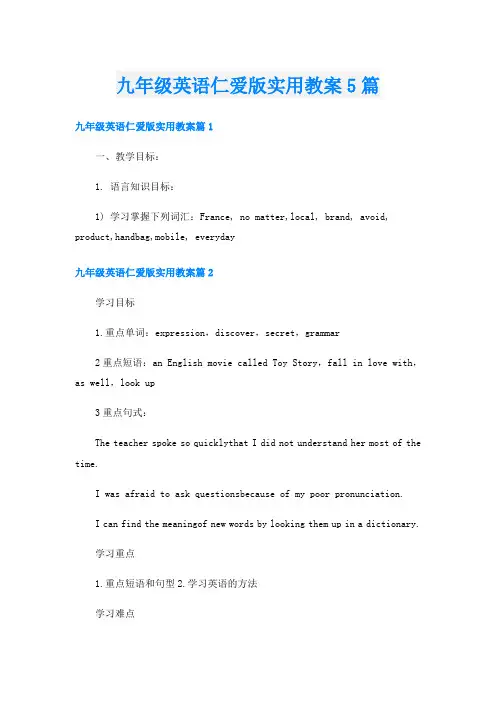
九年级英语仁爱版实用教案5篇九年级英语仁爱版实用教案篇1一、教学目标:1. 语言知识目标:1) 学习掌握下列词汇:France, no matter,local, brand, avoid, product,handbag,mobile, everyday九年级英语仁爱版实用教案篇2学习目标1.重点单词:expression,discover,secret,grammar2重点短语:an English movie called Toy Story,fall in love with,as well,look up3重点句式:The teacher spoke so quicklythat I did not understand her most of the time.I was afraid to ask questionsbecause of my poor pronunciation.I can find the meaningof new words by looking them up in a dictionary.学习重点1.重点短语和句型2.学习英语的方法学习难点学习英语的方法自主学习一、预习课本P3新单词并背诵,完成下面的汉译英。
1.表达_________2.发现________3.秘诀_______4.语法______二、认真预习P3找出下列短语和句型。
1.一部叫做Toy Story的电影2.喜欢上3.也4.老师说得如此的快以至于我大多数时间都不明白。
5.因为我的发音很差,我害怕问问题。
6.我通过在字典里查询找到新单词的意思。
课堂导学Step 1情景导入Teacher:Wei Fen really likes English and sheis a student who is good at English but she didnt use to like English.Do you knowwhat has changed her?Lets read the passageto find the answer.环节说明:由Wei Fen英语成绩的变化为话题,引起学生的好奇,同时又引出要学的内容。
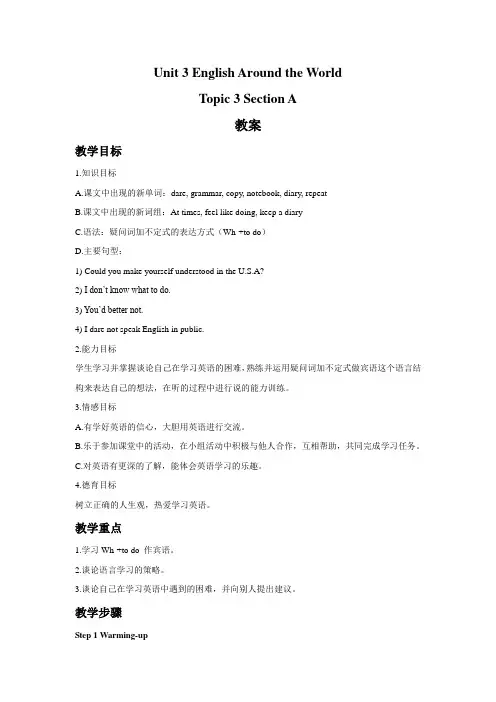
Unit 3 English Around the WorldTopic 3 Section A教案教学目标1.知识目标A.课文中出现的新单词:dare, grammar, copy, notebook, diary, repeatB.课文中出现的新词组:At times, feel like doing, keep a diaryC.语法:疑问词加不定式的表达方式(Wh-+to do)D.主要句型:1) Could you make yourself understood in the U.S.A?2) I don’t know what to do.3) You’d better not.4) I dare not speak English in public.2.能力目标学生学习并掌握谈论自己在学习英语的困难,熟练并运用疑问词加不定式做宾语这个语言结构来表达自己的想法,在听的过程中进行说的能力训练。
3.情感目标A.有学好英语的信心,大胆用英语进行交流。
B.乐于参加课堂中的活动,在小组活动中积极与他人合作,互相帮助,共同完成学习任务。
C.对英语有更深的了解,能体会英语学习的乐趣。
4.德育目标树立正确的人生观,热爱学习英语。
教学重点1.学习Wh-+to do 作宾语。
2.谈论语言学习的策略。
3.谈论自己在学习英语中遇到的困难,并向别人提出建议。
教学步骤Step 1 Warming-upFree talks用大屏幕显示本节课的课题Could you give us some advice on how to learn English well?T: Today we are going to learn English. We can also sa y “We are learning English today.”T: Are you good at English? Do you have difficulty in learning English? 谈到学生学英语遇到的困难,这个贴近学生学习的问题一下子就通能够吸引学生的注意力。
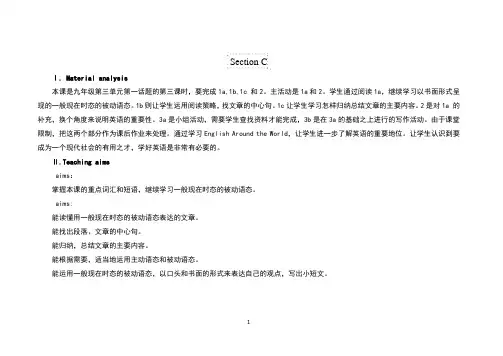
Section CⅠ. Material analysis本课是九年级第三单元第一话题的第三课时,要完成1a,1b,1c 和2。
主活动是1a和2。
学生通过阅读1a,继续学习以书面形式呈现的一般现在时态的被动语态。
1b则让学生运用阅读策略,找文章的中心句。
1c让学生学习怎样归纳总结文章的主要内容。
2是对1a 的补充,换个角度来说明英语的重要性。
3a是小组活动,需要学生查找资料才能完成,3b是在3a的基础之上进行的写作活动。
由于课堂限制,把这两个部分作为课后作业来处理。
通过学习English Around the World,让学生进一步了解英语的重要地位。
让学生认识到要成为一个现代社会的有用之才,学好英语是非常有必要的。
Ⅱ.Teaching aimsaims:掌握本课的重点词汇和短语,继续学习一般现在时态的被动语态。
aims:能读懂用一般现在时态的被动语态表达的文章。
能找出段落、文章的中心句。
能归纳,总结文章的主要内容。
能根据需要,适当地运用主动语态和被动语态。
能运用一般现在时态的被动语态,以口头和书面的形式来表达自己的观点,写出小短文。
1aims: (optional)通过学习,激发学生对英语的需求,让学生自发地从“要我学”变为“我要学”,实现从外驱动到内驱动的转变。
awareness: (optional)了解英语对世界文化交流和许多行业的影响力。
Ⅲ. The key points and difficult points1. Key points:Words and phrases: speaker, foreign, European, tourist, base, tourism, conference, kingdom, native, mother tongue, as well as, play an important part in.Sentences: It is clear that the English language is becoming more important.The English language plays an important part in our lives.Grammar: the simple present passive voice2. Difficult points:能记住不规则动词的过去分词。
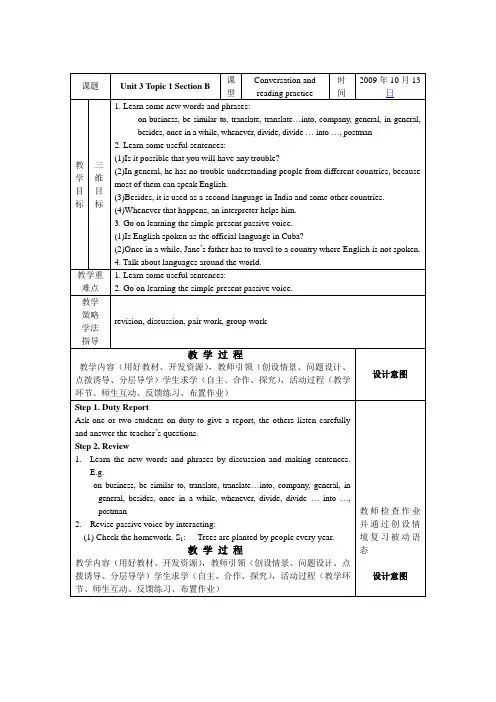
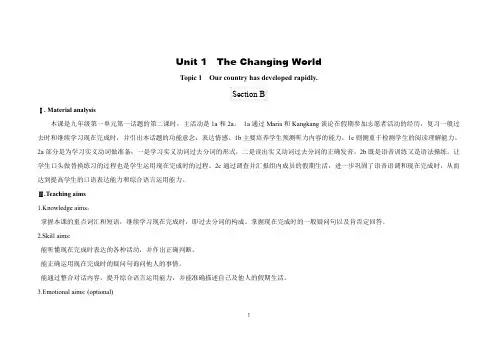
Unit1The Changing WorldTopic1Our country has developed rapidly.Section BⅠ.Material analysis本课是九年级第一单元第一话题的第二课时,主活动是1a和2a。
1a通过Maria和Kangkang谈论在假期参加志愿者活动的经历,复习一般过去时和继续学习现在完成时,并引出本话题的功能意念:表达情感。
1b主要培养学生预测听力内容的能力。
1c则侧重于检测学生的阅读理解能力。
2a部分是为学习实义动词做准备:一是学习实义动词过去分词的形式,二是读出实义动词过去分词的正确发音。
2b既是语音训练又是语法操练。
让学生口头做替换练习的过程也是学生运用现在完成时的过程。
2c通过调查并汇报组内成员的假期生活,进一步巩固了语音语调和现在完成时,从而达到提高学生的口语表达能力和综合语言运用能力。
Ⅱ.Teaching aims1.Knowledge aims:掌握本课的重点词汇和短语,继续学习现在完成时,即过去分词的构成。
掌握现在完成时的一般疑问句以及肯否定回答。
2.Skill aims:能听懂现在完成时表达的各种活动,并作出正确判断。
能正确运用现在完成时的疑问句询问他人的事情。
能通过整合对话内容,提升综合语言运用能力,并能准确描述自己及他人的假期生活。
3.Emotional aims:(optional)1九年级上册教学案例设计在学习过程中,结合小组竞赛、同伴互助等活动,培养互助进步的合作精神。
引导学生了解不同的假期生活,发扬乐于助人的传统美德。
4.Culture awareness:(optional)Ⅲ.The key points and difficult points1.Key points:Words and phrases:shut,ever,rope,disabled,take part in,disabled children’s home,learn…from…,put on,jump rope,chat on line Sentences:I think it makes me happy to help others.Though I had no time to travel,I still felt very happy.To help others makes us happy.A:Have you been to any other places?A:Ann has chatted on line,hasn’t she?B:No,I haven’t.B:No,she hasn’t.Grammar:Present Perfect(past participle和疑问句的问答).2.Difficult points:能巧记过去分词的构成。
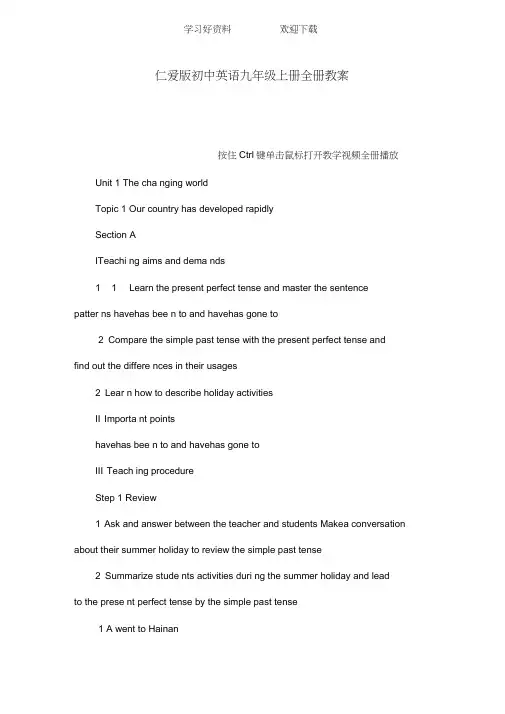
仁爱版初中英语九年级上册全册教案按住Ctrl键单击鼠标打开教学视频全册播放Unit 1 The cha nging worldTopic 1 Our country has developed rapidlySection AITeachi ng aims and dema nds1 1 Learn the present perfect tense and master the sentencepatter ns havehas bee n to and havehas gone to2 Compare the simple past tense with the present perfect tense andfind out the differe nces in their usages2 Lear n how to describe holiday activitiesII Importa nt pointshavehas bee n to and havehas gone toIII Teach ing procedureStep 1 Review1 Ask and answer between the teacher and students Makea conversation about their summer holiday to review the simple past tense2 Summarize stude nts activities duri ng the summer holiday and leadto the prese nt perfect tense by the simple past tense1 A went to HainanA has bee n to HainanUse the same way to lead students to write down B has been to a com mun ity service cen ter2 Lead students to learn the structure of the present perfect tenseHavehas past participleStep 2 Prese ntati on1 Create a real situation to present the newwords and phrase properbythe waybell and volun teer Master proper by the way and bell Know themeaning of volun teer2 Liste n to 1a and an swer the shining questi ons Check the an swersWhere has Rita bee n Where has Jane bee n What about Maria3 Write dow n the an swers on the blackboard And use figure picturesto show have has been to and havehas gone to Then explain the differences betwee n them按住Ctrl键单击鼠标打开教学视频全册播放Step 3 Con solidati on1 Liste n to 1a aga in and finish 1b Retell the dialog accordi ng to 1aand talk about the childre ns vacati on experie nee with has bee ngone to2 Let students find out something important and difficult in 1a Theteacher writes dow n the senten ces on the Bb and expla in them3 Read 1a in groups and choose several groups to act it out Finish 1a4 Work in groups Make up dialogs like 1a accordi ng to stude nts real situations and act them out I pairs Finish 1cStep 4 Practice1 Let stude nts look at the picture in2 and read the dialogs aloudFill I the blanks Finish 2 Let students have a better understanding about the differe nces betwee n havehas bee n to and havehas gone to2 Lear n and master the new words gran dpa chairwoma n and grandson by using word formati on3 Let stude nts find differe nt sentence patter ns of the perfect tense in this sect ion and practice themStep 5 Projectwork after class1 Free work2 Do some exercise about havehas bee n and havehas goneHan dwriti ngOur country has developed rapidlySection Aby the way Where have you bee n JaneThere goes the bell I have bee n toproper Maria isnt at school Wheres shechairwoman She has gone to 按住Ctrl键单击鼠标打开教学视频全册播放Section BITeachi ng aims and dema nds1 Go on lear ning the usage of the prese nt perfect tense2 Compare the teenagers life in the past with that nowadays and lead stude nts to cherish the happy life at prese ntII Importa nt points1 Past Participle2 The usage of the prese nt perfect tenseIII Teach ing procedureStep 1 Review1 Check the work after class2 Ask and answer between the teacher and students Review the present perfect tenseStep 2 Prese ntati on1 Showsomepictures of disabled children Makea dialog with students to knowwhether they have helped disabled children and lead to 1aUn dersta nd the new word disabed and master ever2 Liste n to 1a and an swer the shining questi ons1 Has Maria ever helped disabled childre n2 What did she do to help themStep 3 Con solidati on1 Let stude nts read 1a and find out the importa nt senten ces and the sentences with the present perfect tense The teacher writes them down on the Bb and expla in them Finish 1a2 Let stude nts observe the past participle of verbs in the fivesentences with the present perfect tense on the Bb Learn the rules of the past participle of verbs Fill in the blanks in 1b with different forms of the verbs Master the new words shut and rope Know the new word on li ne Check the an swers3 Make a survey about stude nts summer holidays Then make up dialogin pairs accordi ng to the table in 1b En courage stude nts to take part in outdoor activities Finish 1bStep 4 Practice1 Show two pctures about the life of tee nagers in the past and atprese nt and the n make a comparis on Lead to 2a Lear n and master the new words and phrase describe in detail educati on develop and developme nt Un dersta nd the words tee nagers childhood support and laborer Know about the new word rapidly2 Let stude nts liste n to 2a and an swer the shining questi onHow did most childre n spe nd their childhood in the past3 Read 2a after the tape Let students mark the stresses and sense-groups Then erase the marks Read 2a aloud in imitation of the tape4 Read 2a again Master the new word granny and know about the new word luckily Finish 2a Compare the different lifestyles in the past and atprese nt of Chin ese tee nagers Finish 2b5 Let stude nts liste n to 2c and fill in the bla nks Check the an swersFi nish 2cStep 5 Projectwork after class1 Free work2 Do some exersice in TOPENGLISHHan dwriti ngOur country has developed rapidlySecti on Bhavelive a hard life 程ave you ever fed the disabled childrenin detaile 梇es I haveNo I havenstIs that so 程as Ann ever ocantcouldnt afford sth 梇es she hasNo she hasnbtgive support to sbgive sb support Now our country has developed rapidlyThough she has no time to travel Sectio n CITeachi ng aims and dema nds1 Go on lear ning the prese nt perfect tense2 Compare the past Beijing with the present Beijing and learn aboutthe great cha nges in China3 In spire stude nts to cherish the happy life at prese nt and tocultivate their patriotismII Importa nt points1 some new words and phrases2 1 My granny has lived in Beiji ng for more tha n forty years2 Beijing has made rapid progress and it has already succeeded inhost ing the 2008 Olympic GamesIII Teach ing procedureStep 1 ReviewReview 2a of Section B Let two students cometo the front to talk aboutthe differe nt lifestyles in the past and no wadays of Chin ese tee nagersLead to the comparis on betwee n the old and today in Beiji ngStep 2 Prese ntati on1 Let stude nts look at the pictures in 1a Discuss with stude nts the differences in life between the old days and today then lead to the passage and let stude nts master the new words and phrases com muni cati on quick keep in touch with far away sort rapid progress make progress already and succeed Un dersta nd the new words n arrow relative telegram reform andope nin g-up and fax Know about leisure and mainly2 Let stude nts skim 1a and find out the topic sentence of 1a Checkthe an swer3 Let stude nts read 1a and an swer the shining questi ons Check thean swers1 Who has see n the cha nges in Beiji ng2 How long has Kan gka ngs granny lived in Beiji ng3 How were the livi ng con diti ons in Beij ng in the 1960s4 How can Chin ese childre n study at prese nt5 What do people use to keep in touch with their frie nds and relatives no wadays4 Let stude nts read 1a by themselves and find out the importa nt anddifficult points The teacher writes them dow n on the Bb and expla ins the difficult onesStep 3 Con solidati on1 Let stude nts read 1a aga in and finish 1b Then check the an swers2 According to the pictures in 1a and the words below them let students at least two studets for each pictureStep 4 Practice1 Work in pairs Complete the table according to 1a Finish 1aIn Beiji ng In the past Nowadays Road House Makeup dialogs in pairs shining the example in 1c according to the table and finish 1c3 Lead students to think about the question Why has Beijing changedso rapidly Lead them to cultivate their patriotism4 Work in groups Accordi ng to the table above let stude nts retell 1a in groups on the basis of 2 Step 3 using the words and senten ces theyve learntStep 5 Projectwork after class1 Free work2 Do some exersice in TOPENGLISHHan dwriti ngOur country has developed rapidlySection Csee on eselfkeep in touch withfar awaymake progressreform and ope nin g-up Sectio n DITeachi ng aims and dema nds1 Review and sum up the prese nt perfect tense2 Learn the basic steps of writing a composition3 Let stude nts get acqua in ted with the cha nges in their hometow nsand stimulate their love for their hometow nsII Importa nt pointsCommuni cati on Living con dition1 Some new words and phrases2 The prese nt perfect tenseIII Teach ing procedureStep 1 Review1 Let students listen to the song Spring Has Arrives Review the present perfect tense and warm up2 The teacher tells students that heshe likes enjoying music best in hisher free time and ask about students leisure activites Lead to 2Step 2 Prese ntati on1 Show the pictures in2 Know about the meaning of each picture2 Work in groups Make a survey about students leisure activities and then make dialogs accordi ng to the example in 2 Finish 23 Showa picture of somechildren who are helping someold people Lead to 1 by ask ing and an sweri ng betwee n the teacher and stude ntsStep 3 Con solidati on1 Liste n to 1 Fill in the bla nks with the help of the words on theleft2 Liste n to 1a aga in Check the an swers Fi nish 13 Educate stude nts to respect and care about the oldStep 4 Practice1 Review and sum up the prese nt perfet tense and importa nt sentence patter ns together in this topic2 Listen to 3a and 3b Then let students compare them with what they have summed up Finish 3a and 3b3 Work in pairs Let students look at the poctures in4 then discussthe shining questi onWhat cha nges have take n place in Li Mings hometow nThe n ask three stude nts to summarize the cha nges4 Let stude nts read Notes and Outl ine in 4 and lear n and master the new words and phrases compositi on note con sider draw up tool and tha nks to Learn the basic steps of writing a composition Finish 4Step 5 Projectwork after classWrite a compositi on en tiled Chan ges in LiMings HometownHan dwriti ngOur country has developed rapidlySecti on Ddraw up Have you ever done I have bee n totha nks to Yes I haveNo I have nt Wheres Mariacon sider Where have you bee n She has gone to Cuba Topic 2 China has the largest populati onSection AITeachi ng aims and demands1 Learn the present perfect tense with just already yet ever and never2 Talk about populatio n3 Lead students to care about the population problem and build up right ideas of populati onII Importa nt points1 yet probably call up Europea n populati on rece nt because of policyn either2 1 So do I2 Neither do my pare nts3 the prese nt perfect tense with just n ever yet ever and alreadyIII Teach ing procedureStep 1 Review1 Ask two students to come to the front to talk about the changes oftheir hometow ns2 Show some pictures that can reflect the large populati on of Chi naPractice a dialog with stude nts Lead to Topic 2 Chi na has the largestpopulati onStep 2 Prese ntati on1 Let students listen to 1a and answer the question Wherehas Kangkang bee n Check the an swer2 Let students read 1a by themselves and finish 1b Check the answersLet stude nts guess the mea nings of yet probably and call up from the con text Theteacher gives expla nati on Then ask them to master them3 Let students find out the important and difficult points and thesenten ces with the prese nt perfect tense The n write them dow n on the Bb and help stude nts to un dersta nd themStep 3 Con solidati on1 Let students read 1a after the tape Pay attention to the pronun ciati on and inton ati on2 Work in pairs Let stude nts read 1a and the n act it out Finish 1a3 Add ano ther two senten ces Have you ever fed them and Beiji ng hasmade rapid progress and it has already succeeded in hosting to the sentences in 3 Step 2 written on the Bb Make students know how to use the five un derl ined words the n help stude nts to sum up the usages of them4 Complete the conversation in 2 and check the answers Teach and let stude nts master Europea n Then act it out in pairs Finish 25 Chain drill Ask students to makesentences with just never yet ever and already Then let them give their senten ces one by one in groupsStep 4 Practice1 Let stude nts sing the song If Youre happy Lead to 3a2 Liste n to 3a and an swer the two questi ons the teacher asked the ncheck the an swers3 Let stude nts read 3a by themselves and find out the importa nt and difficult points Then solve them together Learn and master the new words rece nt and n either4Let stude nts read 3a aga in and finish 3b Then check the an swers5 Work I pairs First let students act 3a out Then let the whole class choose the best pair and give them praise Finish 3a Step 5 Projectwork after class1 Free work2 Do some exersice in TOPENGLISHHan dwriti ngChina has the largest populati onSection Acall up everSo do I n everNeither do my pare nts alreadyjustHaveHas done yetIt seems thatI dont thi nk Sectio n BITeachi ng aims and dema nds1 Go on lear ning the prese nt perfect tense2 Lear n how to express big nu mbers in En glish3 Talk about the populati on in differe nt coun triesII Importa nt points1 the numbers with million and billion2 some useful senten ces1 It says the world has a population of 65 billion2 It is in creas ing by 80 milli on every year3 Which country has the largest populati on4 梂hatns the population of the USA桰ths5 So it is6 The population problem is more serious in developing countriesIII Teach ing procedureStep 1 Review1 Check the homework2 Let stude nts report the in formati on about Chinas populatio n thatthey have collected Lead to 1a Then the teacher sums up3 Write dow n the new words in crease and billi on on the Bb Ask stude nts to master the new word in crease and un dersta nd the new word billio n Step 2 Prese ntati on1 Liste n to 1a and an swer the shining questi ons1 Whats the populati on of the world2 Which country has the sec ond largest country2 Let students skim 1a find out the numbers in the dialog and make dialogs in pairs accord ing to the chart and examples in 1b Finish 1b3 Let students read 1a and find out the important and difficult points Write them dow n on the Bb and en courage stude nts to solve the problems Give stude nts someproper compleme ntsStep 3 Con solidati on1 Let students read 1a again and underline the key words Let students change the dialog of 1a into a short passage and try to retell it withthe help of the key words2 Work in pairs Let stude nts read 1a and act it out Fini shi 1aStep 4 Practice1 First the teacher writes a two-digit number then adds a new digitto the nu mber each time Ask stude nts to read the nu mbers correct them properly whe n they make mistakes and the n sum up how to read and write nu mbers in En glish For example22222222222222222222 Let stude nts read the nu mbers in 2a Ask stude nts to express the numbers skillfully with the words hundred thousand million and billionHelp them when necessary and then chenk the answers Finish 2a3 Let stude nts liste n to 2b and dinish it by themselves Check the an swers4 Play a nu mber game optio nalStep 5 Projectwork after class1 Free work2 Do some exersice in TOPENGLISHHan dwriti ngChina has the largest populati onSecti on Bhavehas a population of It says the world has a population of 65billi onin crease by Whats the populati on of the USAthe developeddevelop ing country 296 millio nSo it isHun dred thousa nd millio n billio n Secti on CITeachi ng aims and dema nds1 Go on lear ning the prese nt tense2 Go on talk ing about the problem of the in creas ing populati on3 Lead stude nts to have right ideas of populatio nII Importa nt points1 some new words and phrases2 1 and about one fifth of the people in the world live in China2 our gover nment has take n many measures to con trol the populati on3 Thanks to the policy China is develop ing quickly and peopleslivi ng con diti ons are improvi ng rapidly4 Its difficult for lots of people to find jobs5 we are short of en ergy and water6 Most cities are more crowded than before and the traffic is much heavierIII Teach ing procedureStep 1 Review1 Showsomecards with big numbers and let one student read the numbers and the others listen to himher and write them down Then check the answers2 Ask some questions to review Section B talk about the population problem and the n lead to 1aStep 2 Prese ntati on1 Let students discuss the questions in 1a Show same pictures of the problem caused by Chinas large populati on such as difficult job-h un ti ngless liv ing space less water heavy traffice nvir onment polluti on etc The teacher sums up the problems and lets stude nts master the new word and phrases difficulty be short of and so far Know about measure and take measures to do sth2 Liste n to 1a and finish 1b and the n check the an swers3 Let stude nts read 1a and find out the key senten ces Lead stude nts to sum up Then write them dow n on th Bb and expla inStep 3 Con solidati on1 Let students listen to 1a again write the key words For example the worlds population the largest population one fifth many difficulties policy work well2 using these key words the teacher leads stude nts to review 1a byasking them questions Use one fifth to lead to 20 percent and let students learn and master the new word perce nt Fi nish 1aStep 4 Practice1 Listen to 2a and finish it alone then check the anwsers Learn andknow about n ewbor n2 Read 2a finish 2b alone and check the an swersStep 5 Projectwork after class1 Free work2 Do some exersice in TOPENGLISHHan driti ngSection Cbe short of one fifth so far difficult adj -difficulty n-difficulties npltake measures to do sth Thanks to the policy Sect ion D ITeachi ng aims and dema nds1 Review and con solidate the usage of the prese nt perfect tense2 Know about the life in cities and the life in the countryside inChina and Can ada3 Talk about different types of families and know about the advantages and disadva ntages of themII Importa nt points1 uni ess couple a couple of market excelle nt keep up with relati onbel ong to2 the prese nt perfect tenseIII Teach ing procedureStep 1 Review1 Check the homework2 Practice betwee nthe teacher and stude nts to review Secti on C3 Ask stude nts Do you like livi ng in a place with a large populati onor a small one and lead to 1aStep 2 Prese ntati on1 Let students talk about their living conditions freely and discussthe teachers question Then introduce a students living conditions in atown And let stude nts lear n and master the new words and phrase couple a couple of market excelle nt and relati on Know about tran sportati on2 Let stude nts read 1a Lear n and master the n ewword and phrase uni ess and keep up with Then lead students to find out the useful expressionsThe teacher expla ins these exprssi ons and asks stude nts to master them3 Let students listen to 1a write down the key words and phrases as they are listening and try to retell 1a according to these key words and phrases Step 3 Con solidati on1 Work in pairs Read 1a and discuss What are the differences betweenSues living place and Limings Then fill out the table and check the answersFi nish 1aItem Populati on En vir onment Shopp ing Tran sportati onPeoples relati on SuesFairm ont Li MingsBeiji ng 2 Lead stude nts to finish 1baccord ing to the key words and the table above Then check the an swersStep 4 Practice1 Discuss the questi on Has Can ada developed more quickly tha n China using the prese nt perfect tense2 Lead students to sumup the present perfect tense II Then let them listen to 2a and read after the tape Consildte the usage of the presentperfect tense Finish 2a3 Lead students to sum up the important phrases and sentences in Topic 2 Then let students listen to 2b and read after the tape Consolidate the usages of these phrases and senten ces Finish 2bStep 5 Projectwork after class1 Free work2 Do some exersice in TOPENGLISHHan dwriti ngChina has the largest populati onSecti on Duni essa couple ofkeep up withSo do ISo it isbel ong to Topic 3 The world has cha nged for the betterSection AITeachi ng aims and dema nds1 Lear n the senten ces of the prese nt tense with for and since2 Lear n the word formatio n of derivatives3 Lear n to care about and describe social developme nt and cha ngesII Importa nt points1 some new words and a phrase2 the prese nt perfect tense with for or sinceIII Teach ing procedureStep 1 Review1 Competitio n1 Divide students into several groups Let students give the participle quickly after the teacher says a verb Then choose the best group and give praise2 Show the shining words with a small Bb Ask students to add some letters to the words make up new words after the examples Lead to the formation of derivatives rootsuffix prefixroot2 Lead stude nts to sum up the rules that gover n the formati on ofderevatives With the help of these rules lear n and master the new wordsdiscover direct possible fair inven ti on and excite Finish 3Step 2 Prese ntati on1 Show some pictures of New York The n ask and an swer betwee n the teacher and stude nts Lear n and master the phrase as a matter of fact2 Liste n to 1a and an swer the shining questi ons1 Does Bob like living in New York2 Were the streets in New York dirty in the past3 Can Bob go to plays con certs and operas every day in New York3 Let students read 1a then find out and master the useful expressionsin 1a The teacher expla ins them For exampleYouve been in New York for a long timeOh you will get used to it very soon if you comeThey used to be but the city hasStep 3 Con solidati on1 Let students listen to 1a again and read it with the tape togetherThen act it out Finish 1a2 Let stude nts write a short passage about New York to compare the differences between the past and present in the streets Traffic restaura nts and linving place accordi ng to 1a Then finish 1bStep 4 Practice1 Let students find out the sentences with the present perfect tense in 1a2 Liste n to 2a and choose the right an swers Un dersta nd flood Finish2Step 5 Projectwork after class1 Free work2 Do some exersice in TOPENGLISHHan dwriti ngThe world has cha nged for the betterSection Aas a matter of fact You have bee n in New York for a long timeThe city has improved a lot since I came here a few years ago Derivatio nsin direct f in direct inven tti on f inven tio nimpossible f impossible un fair f un fairdiscover f discover excite ing f excit ing Secti on B ITeachi ng aims and dema nds1 Go on learning the present perfect tense with since and for and thediffere nces betwee n the prese nt perfect tense and the simple past tense2 Lear n the word formatio n of compo unds3 Lear n to take care of others and make the world full of loveII Importa nt points1 some new words and a phrase2 the prese nt perfect tense with for or sinceIII Teach ing procedureStep 1 Review1 Review 1a in Section A Let students find out the sentences with the prese nt perfect tense Rewrite the senten ces using since or for2 Draw a time axis and learn to change the transient verbs in the simple pasttense into the contin uity verbs in the prese nt perfect tense Go onlearning the usage of since and for Finish 2a3 Let students fill in the blanks with since and for after the aboveexamples Then lead students to sumup the rules of changing the transient verbs into the con tiuiety verbs1 Kate bought a new bike two days agoKate has had a new bike two days two days ago2 Ann borrowed a book a week agoAnn has kept a book a week ago a week3 My uncle joined the Party last yearMy un cle has bee n in the Party last yearMy uncle has been a member of the Party。
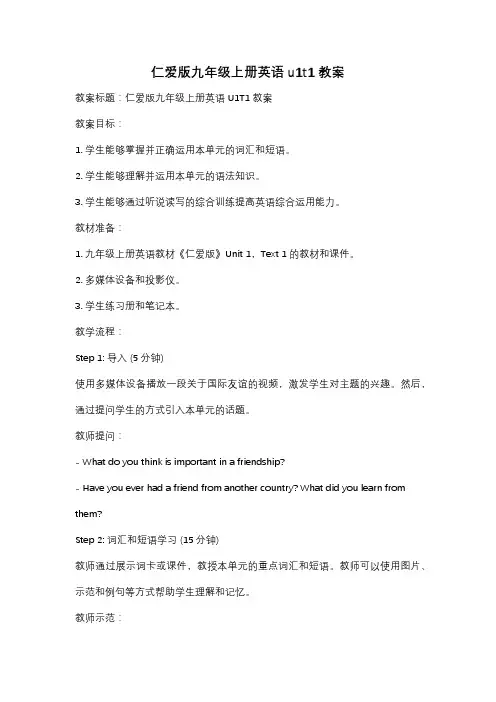
仁爱版九年级上册英语u1t1教案教案标题:仁爱版九年级上册英语U1T1教案教案目标:1. 学生能够掌握并正确运用本单元的词汇和短语。
2. 学生能够理解并运用本单元的语法知识。
3. 学生能够通过听说读写的综合训练提高英语综合运用能力。
教材准备:1. 九年级上册英语教材《仁爱版》Unit 1,Text 1的教材和课件。
2. 多媒体设备和投影仪。
3. 学生练习册和笔记本。
教学流程:Step 1: 导入 (5分钟)使用多媒体设备播放一段关于国际友谊的视频,激发学生对主题的兴趣。
然后,通过提问学生的方式引入本单元的话题。
教师提问:- What do you think is important in a friendship?- Have you ever had a friend from another country? What did you learn from them?Step 2: 词汇和短语学习 (15分钟)教师通过展示词卡或课件,教授本单元的重点词汇和短语。
教师可以使用图片、示范和例句等方式帮助学生理解和记忆。
教师示范:- friendship: a relationship between friends- international: involving two or more countries- cultural exchange: the sharing of ideas, beliefs, and customs between different culturesStep 3: 听力训练 (20分钟)播放录音,让学生跟读并回答相关问题。
然后,再次播放录音,让学生填写相关信息。
教师指导:- 让学生先听一遍录音,不要求他们回答问题,只是让他们熟悉录音内容。
- 第二遍播放录音时,让学生回答问题或填写信息。
Step 4: 语法练习 (15分钟)教师通过讲解和练习,教授本单元的语法知识。
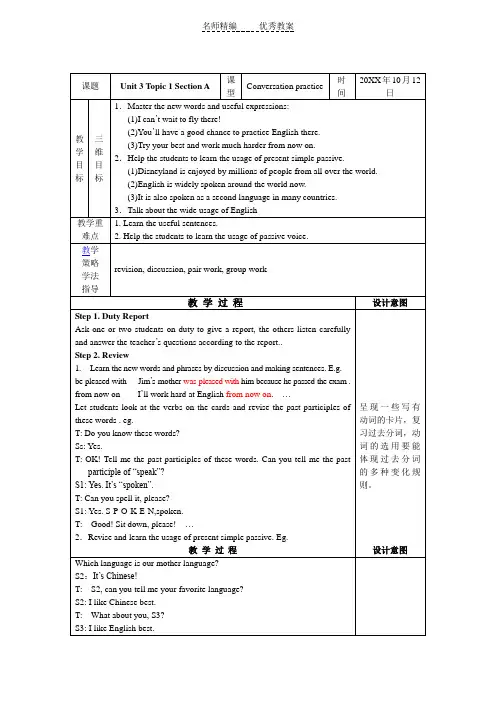
仁爱版英语九年级上册教案教案标题:Unit 1: Welcome to the World of English教案目标:1. 通过本单元的学习,学生将能够熟悉并正确使用一些英语问候语和介绍自己的表达方式。
2. 学生将能够通过对话和交流表达自己的意见和喜好。
3. 学生将能够通过听力和阅读理解简短的英语对话和文章。
教学重点:1. 学习和掌握一些日常英语问候语和自我介绍的表达方式。
2. 学习和练习通过对话和交流表达自己的意见和喜好。
3. 提高学生的听力和阅读理解能力。
教学准备:1. 教材:仁爱版英语九年级上册2. 多媒体设备:投影仪、音响设备等3. 教学素材:英语问候语和自我介绍的图片、对话和文章的录音文件等教学步骤:一、导入(5分钟)1. 利用多媒体设备播放一段英语问候语和自我介绍的视频,引起学生的兴趣。
2. 引导学生思考并讨论他们在日常生活中使用的英语问候语和自我介绍的方式。
二、新课呈现(15分钟)1. 展示英语问候语和自我介绍的图片,引导学生学习和模仿正确的表达方式。
2. 播放录音文件,让学生跟读和模仿录音中的对话和自我介绍。
3. 利用多媒体设备展示对话和文章的文字,帮助学生理解并记忆相关内容。
三、合作学习(20分钟)1. 将学生分成小组,让他们在小组内练习对话和自我介绍。
2. 每个小组派出一名代表,进行对话和自我介绍的展示,其他小组成员进行评价和提出改进意见。
四、巩固练习(15分钟)1. 利用多媒体设备播放一段英语对话,让学生通过听力理解并回答相关问题。
2. 分发练习题,让学生阅读理解相关文章并回答问题。
五、拓展延伸(10分钟)1. 让学生分组进行角色扮演,模拟真实场景中的问候和自我介绍情景。
2. 鼓励学生运用所学内容,进行更多的交流和对话练习。
六、作业布置(5分钟)1. 布置课后作业:要求学生根据所学内容,编写一段自我介绍的英文稿件。
2. 提醒学生预习下一课的内容。
教学反思:通过本节课的教学,学生能够熟悉并掌握一些英语问候语和自我介绍的表达方式,同时也提高了他们的听力和阅读理解能力。
仁爱版英语九年级上册教学设计Unit3 Topic2Section A源城区光明学校王育芬教材分析:本单元围绕着世界语言——英语展开,谈到了英语的广泛应用、英语学习的重要性、不同国家应用应用英语的差异、英语的发展、手势语、英语学习策略。
这些话题与学生的英语学习息息相关、本课时主要呈现语法为现在进行时表将来的用法。
学情分析:对于九年级的学生来说,部分学生已经有了一定的英语学习基础,掌握了一点英,美国家日常生活中的不同传统特点,但总体上来说,还比较少.夏季课程安排与学生的生活紧密相连,也是他们很感兴趣的话题,如有机会,他们也想出国体验英美人家的风土人情,生活习惯。
基于现实生活,只能引导他们发挥自己丰富的想象力,把课堂模拟成生活,置身于学习之中,提高语言交际能力。
然而大部分学生对英美两国的旅游胜地,风土人情等了解甚少,因此词汇量偏大,加之大部分学生的英语成绩分化较严重,所以要求学生做好预习,借助网络和书籍,了解中英美之间生活的特点和差异,培养学生的自学能力。
在教师预设的任务中,注意引导学生在动态中生成。
这样就有利于学生更好地通过课本,达到英语的语言运用能力。
教学目标:1.初步学习现在进行时表示将来时的用法。
2.了解不同英语国家所讲英语的差异。
教学步骤:一.写出下面动词的过去式、过去分词和现在分词。
sink--- have--- lie---die--- run--- beat---hide--- win--- think---二.在文中划出下列短语并翻译。
I can’t follow you._________________ Australian English_________________ British English____________________ the same as _________________________be similar to_____________________call sb._____________________________English-speaking countries____________________________ instead of___________ put my suitcase in the trunk of the car_____________________________________by the way__________________depend on _______________differences between …and …________________________________be a little different from_________________ succeed in doing___________________ make yourself understood____________________ take one’s exam__________________ autumn\fall_______________________________ face to face___________________三、在文中找出下面的句子进行分析:1.Can you speak more slowly, please?译:________________________________________________________思考:有关“说”的词汇:_________(说话,说语言); _________(告诉,讲述);________(说…);__________(谈话)练习:a.Can you _________ English or Chinese? 译:______________________________________________b.He ________ that he had finished his task.译:_____________________________________________c.He is a funny man, he always ________ jokes to us. 译:______________________________________d.Let’s _________ about our plan, shall we? 译:_____________________________________________2. I just said hello to you.译:___________________________________点拨:say hello to sb.---给某人打招呼拓展: 给某人道歉__________________给某人告别__________________给某人道谢_____________________练习:1.因为我的错误我应对他说声抱歉。
仁爱版九年级上册教案第一课:Self-Introduction教学目标:1. 学会用英语进行个人介绍。
2. 练习使用正确的语调和发音进行口语表达。
3. 学习一些常用的问候语和礼貌用语。
教学内容:1. 学生自我介绍。
2. 听力练习:听取他人的自我介绍并回答相应问题。
3. 口语练习:学会使用正确的个人介绍和问候语。
教学步骤:1. 导入新课:引导学生回顾并复习一些问候语和礼貌用语。
2. 学生自我介绍:学生轮流进行个人介绍,包括自己的名字、年龄、爱好等。
3. 听力练习:播放录音,让学生听取录音中的他人自我介绍并回答问题。
4. 口语练习:学生彼此之间进行情景对话练习,使用已学的问候语和个人介绍。
5. 总结讲解:对学生的表现进行总结讲解,纠正他们可能存在的发音和语法错误。
教学评价:教师可以通过注意学生的发音准确性、语法正确性和流利度来评价学生的表现。
同时,教师可以在课堂上进行实时点评和指导,以帮助学生提高口语表达能力。
第二课:Family Members教学目标:1. 学会用英语介绍自己的家庭成员。
2. 练习使用第三人称单数形式的动词。
3. 加深学生对家庭成员的理解和情感。
教学内容:1. 家庭成员的称呼。
2. 家庭成员的介绍和描述。
3. 家人关系的表达。
教学步骤:1. 导入新课:通过图片、视频等形式向学生介绍一些英语国家的家庭成员称呼。
2. 家庭成员的介绍:学生自己介绍自己的家庭成员,并描述他们的外貌、性格等特点。
3. 家人关系的表达:教师通过演示、实例等方式教授家庭成员之间的关系用语。
4. 口语练习:学生进行情景对话练习,介绍自己的家庭成员并问候对方的家庭成员。
5. 总结讲解:对学生的表现进行总结讲解,纠正他们可能存在的发音和语法错误。
教学评价:教师可以通过听取学生的家庭成员介绍和描述,以及他们在对话中使用家人关系用语的准确性来评价学生的表现。
第三课:Hobbies and Interests教学目标:1. 学会用英语谈论自己的兴趣爱好。
仁爱版九年级上册英语教案(一)教案:仁爱版九年级上册英语课程概述•课程名称:仁爱版九年级上册英语•适用对象:九年级学生•准备时间:5分钟•教学时间:40分钟•教学目标:通过本课程的学习,学生将能够掌握九年级上册英语的相关知识,包括词汇、语法、听力和口语等。
教学内容1.单元一:Welcome to the unit–词汇:greet, introduce, occupation, nationality–语法:用于问候和介绍的句型–听力:听取他人的自我介绍并回答问题–口语:借助图片进行自我介绍练习2.单元二:School life–词汇:curriculum, timetable, assignment,extracurricular–语法:现在进行时和一般现在时的用法–听力:听一段对学生日常学习和活动的描述,并回答相关问题–口语:描述自己的学校生活和活动安排3.单元三:Communication breakdown–词汇:misunderstand, apologize, explanation, clarify–语法:情态动词的用法–听力:听一段出现沟通问题的对话,并回答相关问题–口语:模拟情景对话,练习沟通解决问题的能力4.单元四:Our future–词汇:career, ambition, goal, profession–语法:一般将来时的用法–听力:听取他人关于未来计划的描述,并回答相关问题–口语:描述自己的未来规划和职业目标1.课堂导入(5分钟)–通过问题和图片激发学生对本单元主题的兴趣。
–引入今日要学习的单词和句型。
2.新知讲解(10分钟)–通过示范和板书讲解本单元的词汇和语法内容。
–激发学生对今日内容的好奇心。
3.听力训练(10分钟)–播放相关听力材料。
–学生回答问题,并进行讨论和解释。
4.口语训练(10分钟)–学生进行小组或配对练习,模拟对话和情景。
–鼓励学生使用本单元所学知识进行交流。
仁爱版九年级上册教案【篇一:仁爱九年级英语上册教案】仁爱英语九年级上册教案unit 1 the changing world topic1 my hometown has become more and morebeautiful.section athe main activity is 1a. 本课重点活动是1a。
Ⅰ. teaching aims and demands 教学目标1. learn some new words and a phrase:proper, by the way, bell, grandpa, chairwoman, grandson2. learn a useful sentence:there goes the bell.3. learn the present perfect tense:(1)rita, you have just come back from your hometown.(2)—where have you been, jane?—i have been to mount huang with my parents.(3)—by the way, where’s maria?—she has gone to cuba to be a volunteer…4. talk about the children’s vacation experiences.Ⅱ. teaching aids 教具录音机/小黑板/学生的旅游纪念照/图片/幻灯片Ⅲ. five-finger teaching plan 五指教学方案step 1 review 第一步复习(时间:7分钟)通过教师询问学生的暑期活动,导入话题,呈现部分生词。
’s begin our class! (教师解释the bell is ringing等于there goes ,板书bell,要求学生掌握。
)t: nice to see you again. did you enjoy your summer holiday? ss: yes.t: hi, s1, where did you go during your summer holiday?s1: i went to …t: s2s home?s2: yes.(板书grandpa,要求学生掌握。
)grandpat: s3, where did you go?s3: i went to the west lake with my father.t: wow! the west lake is a beautiful place. what did you do there?s3: i enjoyed the beautiful scenery, took photos and bought many beautiful postcards.t: s4, what about you?s4: i had to stay at home to help my mother with the housework.t: oh, i feel glad for what you did, and i think you’re a good girl. you’re helpful. s5, did you go to summer classes?s5: yes, i did. i went to an english training school to improve my english. i think the english training school is a nice placefor me to improve my english.t:)’s come to the new unit now.step 2 presentation 第二步呈现(时间:15分钟)创设语言情境,呈现have/has been to和have/has gone to及部分生词。
1. (创设对话情境。
mr. smith星期六组织class 2去野营,大家在校门口集合时发现jim没来。
师生对话,呈现have/has gone to…) mr. smith: hello, everyone! jim isn’t here. where is he?s1: maybe he is at home.s2: maybe he is ill.…(板书并让学生了解volunteer,教师适当讲解have/has gone to的用法,并让学生初步掌握。
) have/has gone to, volunteer(假设星期一jim返回学校,mr. smith和jim展开对话,呈现have/has been to。
) jim: good morning, mr. smith.mr. smith: good morning, jim. you have just come back from beijing. how was your trip? jim: cool!(板书并适当讲解,要求学生初步掌握。
)have/has been to(教师可用简笔画呈现have/has been to和have/has gone to,讲解它们的区别并要求学生掌握。
)2. (师生对话,简单操练have/has been to和have/has gone to的用法。
)(教师特意让s3去办公室取作业。
)t: did you have a good summer holiday, s4?s4: yes.t: where have you been?s4: i have been to …t: 3?s4: he has gone to the teacher’s office.,要求学生掌握。
)1a的主要内容。
)t: now, listen to 1a. kangkang and his friends are talking about their different experiencesduring the holiday. answer the following questions on the small blackboard:(出示小黑板。
)(1) who has just come back from india?(2) where has jane been?(3) where has kangkang been?(4) who isn’t at school?t: from 1a, we know someone has just come back from india. who is she?(教师加重语气读has just come back。
)s5:rita.t: yes. you have the right answer. rita has been to her hometown in india in her summer holiday. but now she is in china. we can say she has been to india. where has jane been? s6: mount huang.(教师引导学生用现在完成时表达。
)t: yes. she has been to mount huang. where has kangkang been?s7: he has been to an english summer school.4. (重放1a录音,总结重点句型并板书。
)en to the tape again. then talk about what they have done.rita has just come back from india. she has been to …jane has been to … kangkang has been to …maria isn’t at school. she has gone to …step 3 consolidation 第三步巩固(时间:10分钟)巩固1a,完成1b,并引导学生区别一般过去时与现在完成时。
1. (让学生分角色读对话,教师巡视并纠正学生发音。
)t: read 1a in roles. pay attention to your pronunciation.2. (学生独立完成1b的表格。
师生共同核对答案,巩固现在完成时have / has been/gone to这一基本句型。
)t: now, please fill in the table in 1b according to 1a.3. (由1a对话引导学生谈论暑期生活,继续巩固现在完成时。
)t: kangkang has been to an english summer school to improve his english. rita has been toindia. what about you? where have you been? and what didyou do? please work in groups of three to talk about your summer holidays.(学生三人一组进行问答。
)t: who will try to act it out in front of the class?(挑几组学生进行表演,并对学生进行适时指导和鼓励。
)example:s1: where did you go last summer holiday?s2: i went to the west lake.s1: (指s2问s3)where has he been?s3: he has been to the west lake.s1: what did you do there?s2: i went boating on the lake.s1: (指s2问s3) what did he/she do there?s3: he/she went boating there.(教师引导学生区别一般过去时与现在完成时。
)step 4 practice 第四步练习(时间:8分钟)完成1c和2,强化练习现在完成时及部分重要词汇。
1. (教师让学生两人一组,每人拿出提前准备好的旅游照片或图片,操练现在完成时。
注意区别一般过去时、一般将来时和现在完成时,完成1c。
)s1: hi, s2. where have you been?s2: i have been to shanghai.s1: what did you do there?s2: i enjoyed the beautiful scenery there.…s3: hi, s4. where is lucy?s4: she has gone to mount tai.s3: when will she come back?s4: she will come back in two days.…2. (根据呈现的have/has been to和have/has gone to,完成2。